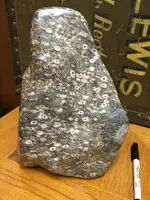That's a nice-sized Turritella Agate (proper name is Elimia Agate) - which is ultimately a coquinite.
It's funny, because by the time they figured out that the Turritella shells were actually Elimia Shells, the books had pretty much been written and the community already had it committed to memory and so the mistaken identification stuck.
It's a sedimentary stone, composed of millions of silicified shell fragments and a base material.
Based off the grey/black/brown matrix, I'm certain it's from the Green River Formation.
Dates back to the Eocene Epoch... It's amazing how something as simple as a decent lapidary polish could make something 30-55 million years old look so nice, huh?
Turritella/Elimia specimens are popular, and also great for fossil enthusiasts/rockhounds that are just starting a catalog as it is relatively inexpensive and easily available. A ton of jewelry makers utilize it... and it also makes for beautiful countertops as well.
I've added a few photos of other known Wyoming specimens, so you can get an idea of the varying degrees of cross-sectioned material and shell density... the spectrum of Turritella/Elimia Agate can range from finely ground bits, all the way up to completely intact shells.







